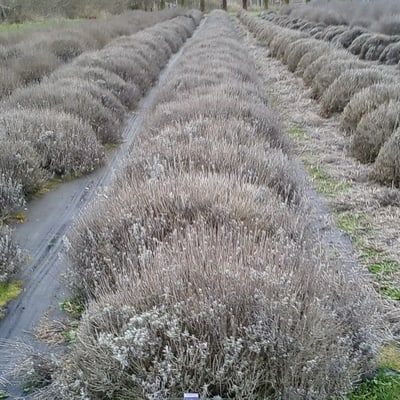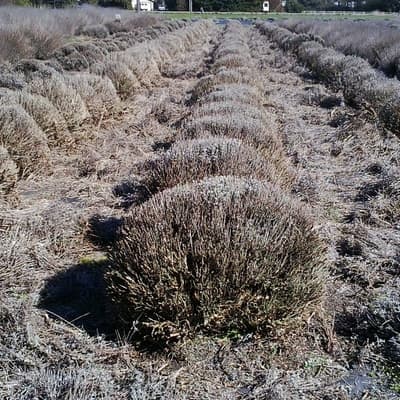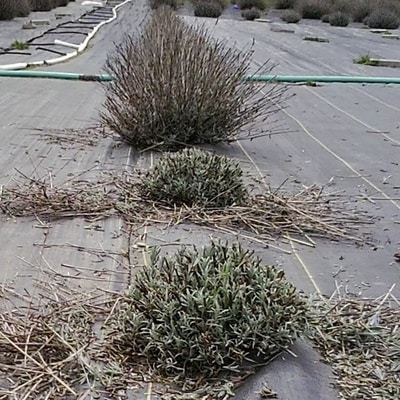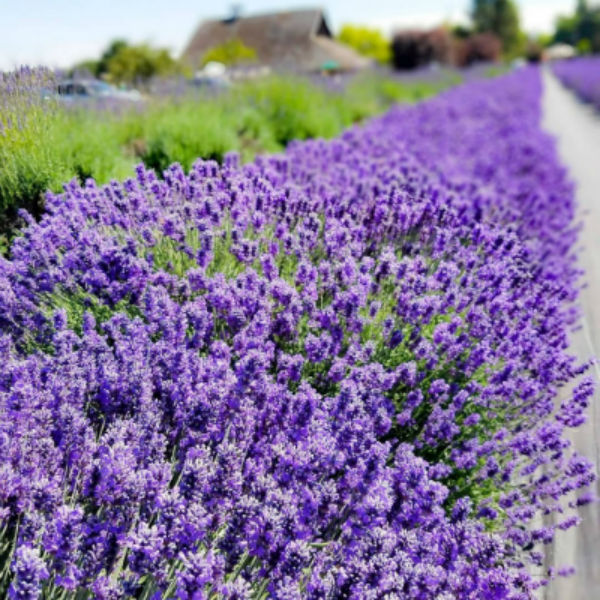It’s springtime, and you just now realized that you forgot to prune your lavender back last fall. You may be wondering: Is it too late? The answer, you’ll be relieved to know, is no! Read on for tips on springtime lavender pruning.
If you have lavender plants that were not pruned back last fall, and if you are located in Western Washington, there is still time to prune your lavender back for the spring.
It is a running joke* in the Olson family that every spring my mother, Susan the Purpled, is convinced that all of the lavender has died and our fields will need to be completely re-planted. So far, every April/May has proven her wrong as new shoots start to pop out and all the grey, woody gumdrops out in the field start glowing with new baby green fuzz.
So if you forgot to trim back your plants last fall or simply prefer to do it in the spring, do not despair if you live in Western Washington: While there is some growth starting on the plants at this time, the middle of March through the first two weeks of April is typically not too late for pruning. You still have a few days to get out there and snip off the ugly bits before the green starts to grow.
Do not be afraid to prune! Pruning is necessary for the health of your plant, as well as helping your plant maintain size and shape. Unpruned lavender will grow unwieldy, and the base will get woody and split. The only way to keep this from happening is annual pruning.
PRO TIPS
- The depth of pruning depends on many things including past pruning practices and size and age of the plants.
- As a general rule we find that most home gardeners tend to prune their plants too lightly, allowing the plants to grow too much each season. Do not be afraid to prune with a heavy hand to control the size.
- Prune to maintain size and for shape. We recommend a gumdrop shape to the lavender when you are done pruning.
Here is a picture of an unpruned Tucker’s Early plant. Tucker’s Early is an angustifolia, which are typically shorter and fatter than intermedia varieties. This plant was lightly pruned in April 2016, and needed to be heavily pruned and shaped in 2017. It looks dead, but we promise you mom, it isn’t.

Below is what the same row looks like, pruned. Please note that because we did light pruning in April 2016, we needed to do heavier pruning and shaping this year. From Farmer Rick: “This resulted in reducing plants starting at an oval of 4 foot x 3 foot wide to a pruned plant you see about 2-1/2 feet diameter circle and 2 foot high.”

This last photo is of our new Impress Purple (an intermedia) which is only 1 year old (awww, baby lavender!) You can see the unpruned lavender behind the recently pruned lavender. From Farmer Rick: “Since the lavender plant is so young, pruning is heavy to shape and control the lavender plant. Heavy pruning at this age helps drive new sprouts for future stems from the base of the plant, making it stronger.”

As you can see, we aren’t afraid to prune *way* back when necessary – as long as you aren’t cutting into the woody part of the plant base, you won’t hurt the plant. Now get your scissors and get out there! Your lavender will thank you.
Edit: It occurred to me that you might want a picture of what a healthy, pruned row of lavender looks like after it blooms – so here you go!

*Clearly by “joke” I mean “Something we tease our mother about” not “Something you should tell at a dinner party.”
pssssst – Thanks for reading our blog! Curious about our natural lavender bath & body products? Enter code ehma3jd6 at checkout for 5% off your next bath & body order at our online store!
22 Replies to “Lavender Care: Spring Pruning”
Colin Byrne
PRUNED! Thanks for the tip 😉 (get it)
Rebecca Olson[ Post Author ]
Slow clap. Well done.
Kathy Freyberg
Question: I planted several English Lavender (Munstead) plants this April. I am panicking as I just read an article that said to cut all of the flowered stems off before they bloom. Is this necessary? They are just starting to look so pretty, as well as looking like real lavender. Also, I had used beauty bark in the garden where all of the Lavender plants were–they had to be replaced this year as they were going on fifteen years old. Another article stated that beauty bark was toxic to Lavender and should not be used. What should I use instead of the bark? Thank you.
Kathy
Rebecca Olson[ Post Author ]
Kathy – those are great questions, and I’ve passed them along to Farmer Rick. We’ll get back to you soon!
Rebecca Olson[ Post Author ]
Kathy – here is Farmer Rick’s response. Good luck!
“Thank you for your questions. They are valid questions and there is not a single correct answer, as in many things lavender. Regarding your first question: whether or not to prune the plants back soon after planting. In my opinion, this advice comes from the desire to force the plant to spur more stem growth from the base of the plant. I often, though not always, prune the plants soon after planting, for this reason. If the small 3” potted plant has only a single or two stems extending from the base crown, I would prune it back to 3” or 4” off the crown. If the 3” potted plant has many separate stems/starts from close to the base, I might only trim the one or two that seem to be trying to take over and dominate the growth, forcing the growth to the smaller starts. You might be surprised as to how much your lavender will enjoy the haircut and give you multiple stems with blooms after this pruning, if done soon. Even if it doesn’t give you buds this summer, your plant will have a healthier start for the long term growth. Prune again in the late fall (October for Western Washington) to a small rounded gumdrop shape 4” to 6” diameter for first year. Future years, pruning can be done in late fall or early spring depending on your preference and a variety of differing opinions.
Regarding your question on beauty bark, I am not sure of the origin of that opinion. It may be true that some types of beauty bark may have impacts on lavender but some may not. (ie cedar vs pine, coarse vs fine, etc.) I have a small garden area in front of our barn store where we placed heavy woven weed fabric down on clean soil, burned 5” holes for planting the lavender and then spread some local large format beauty bark to 4” deep. It has been in place for 6+ years and the 4 different varieties of lavender both angustifolia and intermedia cultivars are all doing great with the lavender plant stems hanging and resting on the bark. I would say that if you want the bark garden groundcover effect, go for it and address any problems that may occur. Most problems I find people have with lavender is that they over water it (place it in a garden of roses that constantly need watering) or plant the lavender in areas with very tight clayey soils or with a high water table (less than 30” minimum). Lavender does not like much water after the first year. Good luck with your lavender! – Farmer Rick”
William Matters
I wanted to know if it is too late to do any pruning at this time in New York on the east end of Long Island?
Thank You,
Bill
Rebecca Olson[ Post Author ]
Bill – I wouldn’t recommend pruning this late in the season. Instead, give them a good haircut when it starts to warm up in the first half of spring. There is nothing harmful about spring pruning – you should still see plenty of growth in time for summer! Good luck.
Cyndi
Hi there! What do you use for pruning?
Rebecca Olson[ Post Author ]
Hello – great question! When we prune the fields, we use a handheld gas powered hedge trimmer (because there are so many plants). However, home gardeners can easily use gardening shears or scissors for basic pruning – whatever is most comfortable for you! If you do need to cut out deadwood, or cut back into any of the wood of the plant for shaping (remember: this should be done sparingly and judiciously) regular hand-held pruners will work just fine. Tip: remember to wear gloves and long sleeves to protect yourself from tiny slivers and scrapes as you prune. The stems themselves are gentle, but the woody base of the plant can be surprisingly abrasive. Also, don’t forget to sterilize your tools before and after use, to avoid spreading disease. Good luck!
Kellie
All my Lavender look dead, I don’t think I pruned enough in the fall, I’m in Michigan and would like to know if a spring prune would help? Also is it possible to root the trimmed parts off and make more lavender plants from them? Thanks in advance.
Rebecca Olson[ Post Author ]
Kellie – If you left some of last year’s stem growth on the plant, you can still prune it back to the wood. But if you pruned back to the wood last fall, I wouldn’t prune any more.
By this time of year your lavender plants should be showing a little bit of green. Do you see any green on them? It’s possible that if you’re in a much colder zone than us your plants are a few weeks behind, but all of our plants have at least *some* green somewhere by now. Check carefully all along the plant for any signs of green/new growth/budding, and if you’re in zone 5 or lower, maybe give it another week or so before giving up hope. You can also check to see if portions of the plant have died and cut the deadwood out – check out my blog “How to tell if your lavender survived the winter” (if you haven’t already.)
For propagation, it is really simple to propagate lavender from cuttings, but they must be live cuttings (dead plant material, like last year’s unpruned stems, won’t work.) However, you can take softwood cuttings from any new green stems that appear this year. I also have a 3 part blog series about that where I walk you through the process of softwood propagation. You can also take cuttings and propagate from hardwood – the basic principles are the same as softwood, though I haven’t had as much luck with this method and am still experimenting. Regardless, the cuttings need to be from live plant material.
So your next best steps are to check the plants thorough and see if you notice any green buds. If so, you can cut the remainder of last year’s old stems back to the wood, but otherwise they’re just taking some time to wake up from winter, so let them do their thing. If you don’t see any green or indication of budding, cut into the hardwood in one small section of the plant (prune off a small branch) and see if there’s green inside. If it’s brown and dead, you may need to go around the plant selectively cutting – if you don’t find any green inside, it’s likely that your lavender didn’t survive the winter.
Keep me posted!
Lavender Care: Growing Lavender in Cold Climates | Lavender Connection
[…] the fall, always prune the plants back (see our tips on pruning) – good pruning will establish a good root ball and help develop a strong woody base for the […]
Did my lavender plant survive? | Lavender Connection
[…] stems could be obscuring the new growth (and delaying budding). Prune it now! Read our blog about spring pruning […]
Lavender Care: Fall Pruning - Lavender Connection
[…] has passed, don’t despair – you can still prune lavender in the spring! Check out our blog Lavender Care: Spring Pruning – (the basic principles are the […]
connie
I live in Southern CA. When should I prune my lavender plants?
Rebecca Olson[ Post Author ]
Connie – hello! We believe it’s best to prune lavender in the fall, so you don’t accidentally cut off new growth in the spring. For those in colder climates (we’re in Maine right now and it snowed a few days ago) then spring pruning is fine because the plants don’t start putting out new growth until May. So it depends on your zone, but with Southern CA I believe it’s warm enough that you probably are too late for spring pruning. If you prune now you risk the chance of cutting off the newly formed buds, and that would mean either a much later bloom this season (or no bloom at all.) I recommend you prune in late September after the summer blooms have died back. Note that you can “harvest” bloomed lavender from the plant at any point in the summer if you keep 1″ or so above the wood of the plant. We harvest in July/August/September and then do a final shaping/pruning in October. Hope this helps!
Barbara Smith
Thank you! This is exactly the kind of info I was looking for. I live in Portland, OR, so I’m guessing the advice is not off the mark for my area.
Rebecca Olson[ Post Author ]
Yes – Portland is typically in zone 8, which is the same as us!
Lisa B.
Hello! I live in zone 7a and was wondering if it’s too late to prune my lavender for fall?
Rebecca Olson
You’re right on the cusp. If the plants are well established (3+ years old) you should be fine. If they’re younger, I would just trim the stems back so they don’t get broken by snow/wind over the winter, then do a real prune in early spring.
Heather
What do you do with the clippings from pruning? I’m inclined to leave where they fall, but curious if there’s any reason not to or if there’s a produce to make from the process.
Rebecca Olson[ Post Author ]
Hello! If you were to prune & harvest now you would be able to use the clippings in a still to extract essential oil (if you have a small tabletop still). We harvest for oil first, then due a true prune to shape the plants later (Sept/Oct) and put the cuttings in the compost. You can leave the cuttings where they are to compost if you want, but there’s always a danger they’ll trap moisture around the base of the plant – you don’t want the plant getting root rot. If you’re in a dry area that won’t be an issue, but here in the PNW we try to sweep/clean before the winter for that reason. Hope that helps!